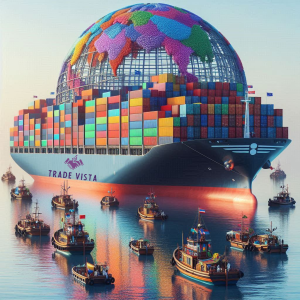India’s textile and apparel industry has always been one of the country’s strongest economic pillars. But over the next five years, the sector is expected to enter a new growth phase—one that could transform the global perception of “Made in India.”
According to industry estimates, the Indian textile and apparel market is projected to grow at a CAGR of 10% and reach US$350 billion by 2030, with exports alone expected to cross US$100 billion. This presents a once-in-a-decade opportunity for Indian manufacturers, traders, and entrepreneurs to tap into the global market.
So, how can you be a part of this growth? Let’s break it down step by step.
1. How Big is the Indian Textile Industry?
The numbers speak for themselves:
- Market Size: US$ 160 billion (FY24) → projected US$ 350 billion (2030)
- Export Earnings: Contributes 10.5% of India’s total export earnings
- Employment: Over 45 million people are employed, making it one of the most prominent job creators in the country
- GDP Contribution: 2.3% of India’s GDP
This scale is a significant advantage for Indian exporters. With the world actively diversifying its supply chains beyond China, India’s competitive manufacturing base is capturing the attention of buyers across the USA, Europe, the Middle East, and the Asia-Pacific region.
2. What Does India Export in Textiles?
India’s textile exports are highly diverse, spanning multiple product categories:
- Ready-Made Garments (RMG): Shirts, dresses, trousers, activewear
- Cotton Yarn & Fabric: One of the largest cotton producers globally
- Man-Made Fibres & Filaments: Polyester, viscose, blended fabrics
- Handloom & Handicrafts: India’s traditional strengths, such as ikat, khadi, and embroidered fabrics
- Home Textiles: Bed linen, curtains, towels
- Jute & Carpets: Eco-friendly and premium home décor products
In FY24, cotton yarn and fabrics held the largest share, followed by RMG and artificial fibre products.
3. Why Global Buyers are Turning to India
a) Diversification from China
International brands and importers are actively reducing their dependency on China. India is emerging as a natural alternative due to its skilled workforce, raw material availability, and competitive pricing.
b) Sustainability and Compliance
Indian exporters are investing heavily in eco-friendly production and certifications, such as GOTS (Global Organic Textile Standard) and OEKO-TEX®, making their products more attractive to environmentally conscious buyers.
c) High Demand in Key Markets
Top destinations for Indian textiles in 2025-2030 include:
- USA – Major market for apparel and home textiles
- UAE and Middle East – Large demand for cotton yarn and RMG
- EU nations (Germany, France, Italy) – High-value luxury and sustainable textiles
- Australia, Canada, Japan – Growing interest in Indian cotton and handicrafts
4. Challenges Every Indian Textile Exporter Should Know
While the opportunity is enormous, exporters must navigate some common hurdles:
- High Logistics Costs: Shipping delays and freight charges can eat into margins.
- International Compliance: Buyers expect consistent quality and certifications.
- Global Competition: Countries like Bangladesh and Vietnam offer lower costs.
- Payment Risks: Without proper safeguards, exporters risk delayed or defaulted payments.
5. How to Start a Textile Export Business in India: Step-by-Step
Starting your textile export business can feel overwhelming, but it’s easier if you follow a structured plan:
- Register Your Business & Obtain IEC:
- Incorporate your company as a sole proprietorship, partnership, or private limited company.
- Get an Import Export Code (IEC) from DGFT—it’s mandatory for exporters.
- Incorporate your company as a sole proprietorship, partnership, or private limited company.
- Get GST and Other Registrations:
- Register under GST and apply for other necessary state licenses.
- Register under GST and apply for other necessary state licenses.
- Source or Manufacture Quality Products:
- Partner with reliable manufacturers or set up your unit. Quality is key to winning repeat orders.
- Partner with reliable manufacturers or set up your unit. Quality is key to winning repeat orders.
- Find International Buyers:
- Join B2B platforms like Alibaba.com, IndiaMART, Fibre2Fashion.
- Attend textile trade fairs and build relationships with sourcing agents.
- Join B2B platforms like Alibaba.com, IndiaMART, Fibre2Fashion.
- Ensure Product Compliance & Certifications:
- Understand buyer requirements, including labels, packaging, and safety standards.
- Understand buyer requirements, including labels, packaging, and safety standards.
- Plan Your Shipping & Logistics:
- Work with trusted freight forwarders and stay updated on customs procedures.
- Work with trusted freight forwarders and stay updated on customs procedures.
- Secure Your Payments:
- Utilize tools such as Trade Assurance, letters of credit (LCs), and export credit insurance from ECGC.
- Utilize tools such as Trade Assurance, letters of credit (LCs), and export credit insurance from ECGC.
6. Government Schemes to Support Textile Exporters
The Indian government has introduced several initiatives to make exports competitive:
- RODTEP & ROSCTL: Refund embedded duties and taxes on exports.
- Production Linked Incentive (PLI) Scheme: Incentives for significant investments in textiles.
- MSME Schemes: Financial support for small and medium textile units.
- Export Credit Guarantee Corporation (ECGC): Reduces payment risk for exporters.
These schemes can significantly boost profitability if planned correctly.
7. Where Can You Find Genuine Global Buyers?
Building a strong presence on B2B platforms is one of the most effective ways to reach international buyers. Platforms like Alibaba.com allow you to:
- Display your products to millions of verified buyers
- Get payment protection through Trade Assurance.
- Build credibility with a verified seller profile.e
Offline trade shows, buyer-seller meets organized by APEDA, FIEO, and industry bodies also work well, but they require higher budgets and travel commitments.
8. Frequently Asked Questions (FAQs)
Q1. Is textile export from India profitable?
Yes, with growing global demand and government incentives, margins can range from 10% to 25%, depending on the product.
Q2. What certifications do I need?
Certifications such as GOTS, OEKO-TEX, and ISO are commonly required for exporters targeting the European Union and the United States.
Q3. Which countries buy the most Indian textiles?
The United States, the United Arab Emirates, Germany, France, and the United Kingdom are the top importers.
Q4. How much investment is required to get started?
A small-scale textile export business can be started with as little as ₹5–10 lakh, especially if you begin as a merchant exporter.
Q5. How do I ensure timely payments from buyers?
Use export credit insurance and reliable payment methods like LCs or Trade Assurance.
The Indian textile industry is poised for exponential growth. With a projected market size of US$350 billion by 2030 and rising demand in global markets, now is the ideal time for Indian businesses to expand their international presence.
If you are new to exporting, start small, focus on building buyer relationships, and leverage government schemes to maximize your margins.
Want to take your textile products global?
TradeVista helps Indian exporters establish their businesses, connect with genuine international buyers, and secure payments through verified channels.
👉 Book a Free Export Consultation Today and start your journey from local to global.




